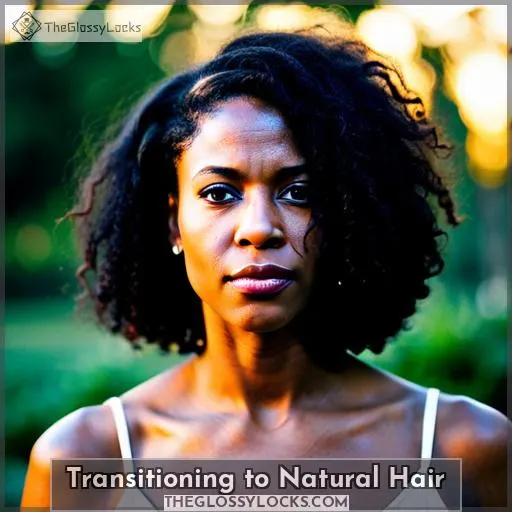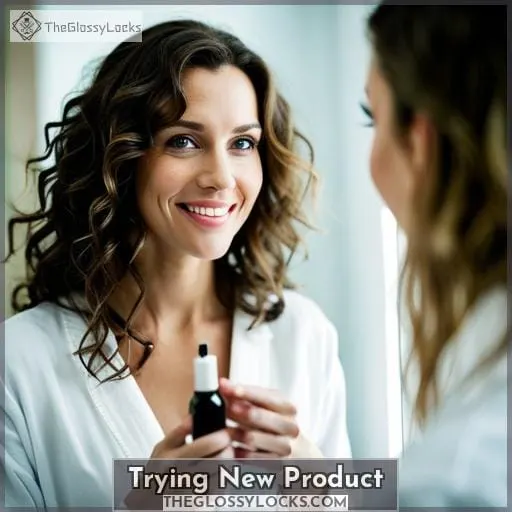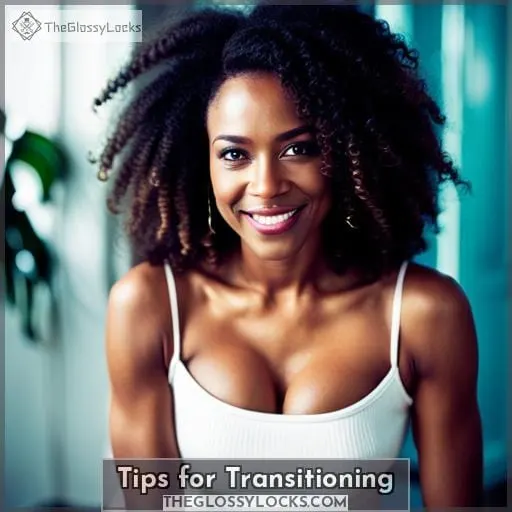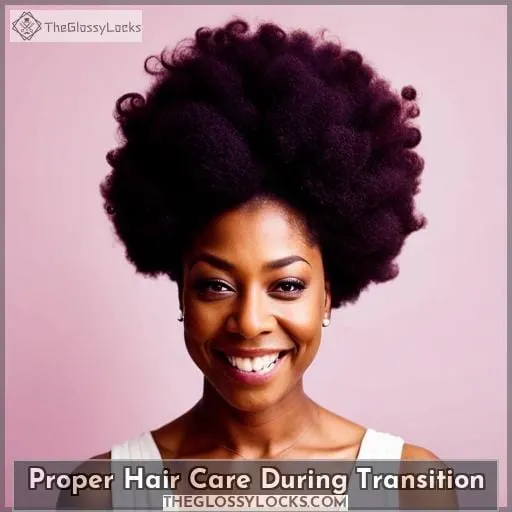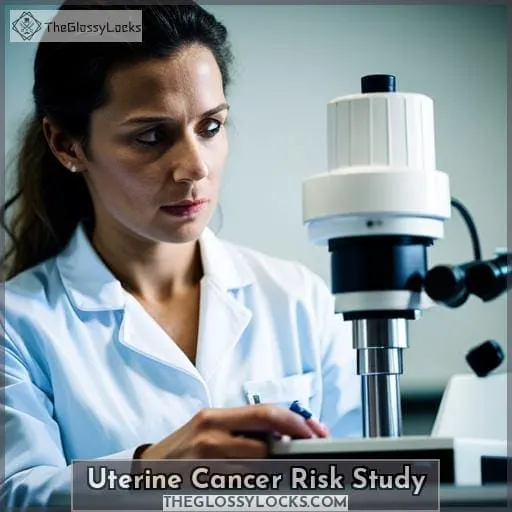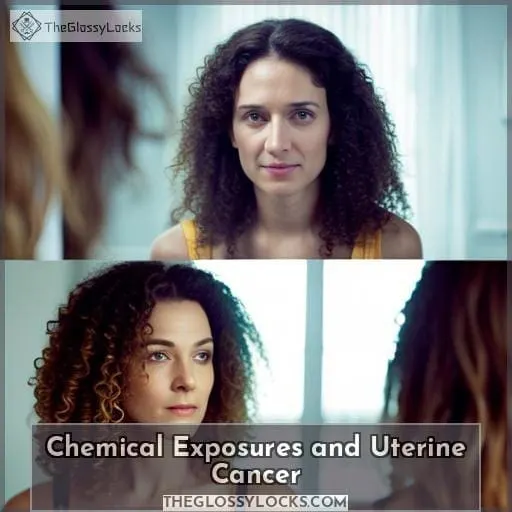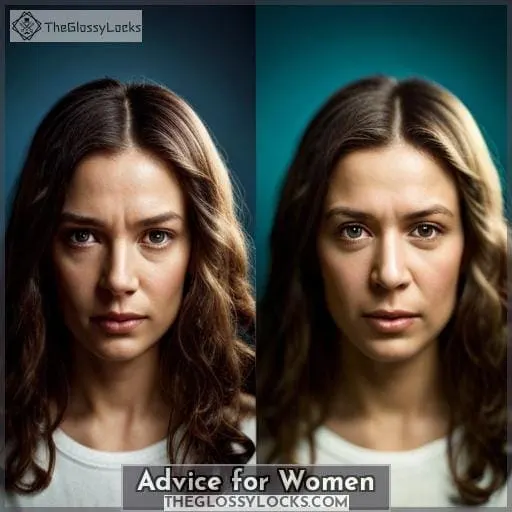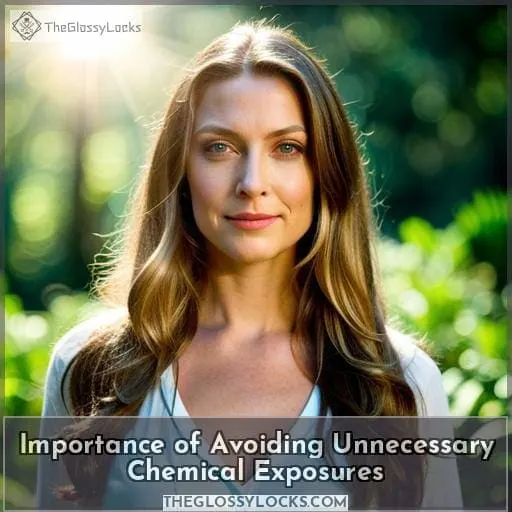This site is supported by our readers. We may earn a commission, at no cost to you, if you purchase through links.
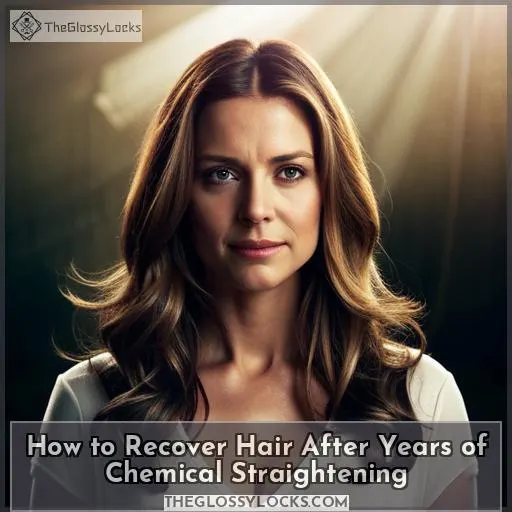
If you’re wondering how to recover hair after years of chemical straightening, look no further – we’ve got all the tips and tricks for bringing back those beautiful spirals! From finding the right products and washing routines to avoiding unnecessary exposures that could increase your risk of uterine cancer, this article has everything needed for making sure your transition goes as smoothly as possible.
So grab your favorite cup of tea (or coffee) and join us on our journey towards embracing all types of natural beauty!
Table Of Contents
- Key Takeaways
- Transitioning to Natural Hair
- Trying New Product
- Tips for Transitioning
- Proper Hair Care During Transition
- Uterine Cancer Risk Study
- Chemical Exposures and Uterine Cancer
- Advice for Women
- Importance of Avoiding Unnecessary Chemical Exposures
- Frequently Asked Questions (FAQs)
- Are there any natural alternatives to chemical straightening?
- How long does it typically take for hair to recover from chemical straightening?
- What ingredients should I look for in a shampoo and conditioner for curly hair?
- Are there any health risks associated with chemical straightening?
- Are there any special techniques I can use to style my curly hair?
- Conclusion
Key Takeaways
- Cutting off chemically straightened ends allows hair to recover from chemical damage.
- Using natural hair products can help reduce chemical exposures and promote hair recovery.
- Deep conditioning weekly can aid in the recovery process from chemical straightening.
- Experimenting with different products optimized for your curl type can help in the recovery of hair from chemical straightening.
Transitioning to Natural Hair
After years of chemical straightening, the only way to reclaim your natural curls was to cut off the straight ends and start fresh. It took patience and time for your curls to fully recover as you had to learn about them through experimentation with different products.
Cutting Off Straight Ends
To embrace your natural curls, cutting off the straight ends of your hair is a necessary step to allow them to return after years of chemical treatment. Dye avoidance can help maintain healthy levels of chemical exposure, and our hair will benefit from regular trims that remove split ends while transitioning.
Choosing the right product for curly texture is essential during this time. Shampoo less often but always condition with a silicone-free conditioner for hydration. Taking transition tips into consideration, such as using heat styling tools or protective styles, is key in managing the risk associated with uterine cancer caused by using certain hair straighteners too frequently.
Keep careful track of progress and don’t forget to deep condition weekly – trust in patience! Your journey towards embracing natural curls starts now!
Patience and Time for Curls to Recover
Gaining back your luscious curls can be a long process, so buckle up and enjoy the ride – it’s worth it in the end! As you transition from chemically straightened hair, it is not recommended to freeze curls with shampoo alternatives.
Instead, focus on heat-free styling methods and conditioning tips as curly regrowth comes in slowly. You should also protect your hair by avoiding treatments that could cause further damage during this time.
Protective hairstyles can help hide multi-textured strands while you wait for full recovery of the natural curl pattern over months or years, depending on how severe the chemical treatment was initially.
Not only will taking care of yourself lead to better results, but embracing patience will pay off significantly as well!
Learning About Curls Through Experimentation
Experimenting with different products and techniques was key to discovering your curls’ unique needs. From product selection to styling tips, finding a balance between hydration and moisture without using harsh chemicals or hair relaxers was essential.
Natural alternatives were explored in order to bring an end to the cycle of breakage, dryness, and chemical straightening that had been part of your journey for so long.
Through trial and error, you began understanding how best to care for natural black hair curly while transitioning from chemically straightened locks back into a world of voluminous coils! With each step taken towards embracing this new look, came confidence in knowing that it would not only be beautiful but also healthy – free from any unnecessary damage caused by heat tools or harsh ingredients.
Trying New Product
After years of chemical straightening, you’ve decided to embrace your natural curls. As part of this transition, you recently tried Function of Beauty’s silicone-free shampoo and conditioner in an effort to optimize your washing routine for the ideal curl results.
You quickly realized that choosing the appropriate products for washing is just as important as selecting styling products when it comes to taking care of curly hair.
Function of Beauty’s Silicone-free Shampoo and Conditioner
Attempting to optimize your wash routine? Give Function of Beauty’s silicone-free shampoo and conditioner a try! Silicone-free products are the safest choice when it comes to chemical safety. They offer an alternative for those looking for straightening solutions without having to wear gloves or worry about the risk of cancer.
Heat treatments, such as hair styling with bisphenol A found in many hair straightening products, may be associated with health issues related to chemicals.
Optimizing Washing Routine for Ideal Curl Results
To optimize your washing routine and achieve the ideal curl results, consider trying a silicone-free shampoo and conditioner such as those from Function of Beauty. Nearly 6.5% of women surveyed reported using straighteners 4+ times per year, with twice the risk for uterine cancer diagnoses.
Learning about curly hair through experimentation with safe products is key to finding a way to wash it that yields light, moisturized locks without sacrificing cleanliness or vice versa.
Product trial should include techniques like co-washing or leave-in conditioners for hydration without overloading hair with product buildup. Deep conditioning weekly helps rehydrate tresses in an effective manner, yet gentle enough not to damage them further than necessary.
Experimentation will reveal how curls respond best when manipulating these components.
Importance of Washing Products in Curl Hair Routine
Choosing the right washing products for your curl routine is key to achieving healthy, light, and moisturized hair. Natural oils can help nourish curls, while specialized curl products provide hydration and definition.
Washing frequency should be adjusted based on product safety, scalp health, and lifestyle. Black women often wash less frequently than other ethnicities because of their natural oil-producing properties.
My hair was damaged from permanent heat treatments, so I had to take extra precautions when selecting my shampoo and conditioner. Finding a silicone-free option that would gently cleanse without stripping away any natural oils was key in helping me recover my curls after chemical straightening.
Tips for Transitioning
If you’re transitioning from chemically straightened hair to natural curls, there are several steps to take. To begin with, avoid using any additional chemical treatments or dyes on your hair during the transition period and have regular trims as your curly locks grow out in order to remove the straight ends.
Additionally, it’s important not to rely too heavily on heat styling tools such as blow dryers or curling irons while transitioning back into having natural curls. Doing so will ensure that you achieve the best results when recovering your original curl pattern.
Avoiding Hair Dyes and Other Treatments
Avoiding hair dyes, perms, and other treatments while transitioning to natural curls is a must – unless you want your head to look like an untamed poodle! Natural oils can help nourish curls during the process.
Protective styles can also be used to hide multi-textured hair as it recovers from regular straightening.
Root touch-ups should be avoided at all costs in favor of letting curly roots grow out on their own. Heat styling tools, such as blow dryers or curling irons, should not be used either since they may cause mechanical damage that delays recovery time or scalp itchiness, which makes for an unpleasant experience overall.
Additionally, reducing chemical exposures associated with straightener use has been linked with lower uterine cancer risk, so opting for natural alternatives is recommended whenever possible.
Regular Trims to Remove Straight Ends
Getting regular trims will help you get rid of the straight ends as your curls grow in, allowing you to embrace your natural texture. When transitioning from chemically straightened hair, protection measures like trimming and avoiding heat damage can go a long way towards curl health.
Consider natural options for styling instead of chemical avoidance – this helps protect against any link between breast cancer and certain products containing harmful chemicals used in the transition process.
Women should be aware that cutting off their straight ends is part of reclaiming their naturally curly hair.
Protecting themselves from potential risks associated with these products is key to keeping healthy during this transition period.
Avoiding Heat Styling Tools
Heed the advice to forgo heat styling tools during your transition, such as curling irons and blow dryers. Heat damage can strip hair of its natural hydration, leading to excessive hair fall and permanent damage.
Keep curls healthy throughout this process!
Proper Hair Care During Transition
As you transition away from chemical straightening, it’s important to develop a proper hair care routine. Washing your hair 2-3 times a week and always conditioning is key to retaining moisture. Additionally, trying co-washing or leave-in conditioners can help keep curls hydrated, while deep conditioning weekly is essential in helping to recover years of damage caused by the chemicals used in straightening treatments.
Washing Hair 2-3 Times a Week, Always Conditioning
Wash your curls 2-3 times a week, always conditioning to keep them moisturized and healthy. Deep condition weekly to rehydrate hair, especially during the transitioning stage from chemically straightened hair.
Co-washing or using leave-in conditioners can also help with hydration while avoiding heat styling tools such as blow dryers and curling irons, which can damage natural curls over time.
When selecting products for curly care, look for silicone-free options with natural ingredients that won’t strip away moisture from the strands or increase the risk of uterine cancer due to frequent use of chemical-based straighteners (photo courtesy).
Experimentation is key in finding the right combination of shampoo and conditioner tailored specifically for your curl type, so you don’t have to rely on post-wash products anymore!
Trying Co-washing or Leave-in Conditioners
Try co-washing or using leave-in conditioners to further optimize your hair care routine and keep your curls hydrated while transitioning away from chemical straightening.
Co-washing has several benefits. It involves using less shampoo, which can strip the scalp’s natural oils. Instead, it provides a moisturizing cleanse that helps protect curly and kinky hair.
To add extra protection against chemical exposure, look for leave-in conditioners that contain plant-based ingredients like aloe vera or shea butter. These ingredients are safer alternatives to traditional products that may contain potentially harmful chemicals.
Regular use of such products could lead to the absorption of these chemicals through the scalp over time.
If you’re ready for a more natural approach during the transition stage of your curl journey, co-washing and using safer alternative products may be just what you need!
Deep Conditioning Weekly
To keep your hair healthy during the transition, make sure to deep condition it weekly. A conditioning routine will help minimize chemical exposures and protect internal hair bonds from damage caused by permanent straightening treatments.
Researchers suggest using safe products like natural alternatives and gloves when using these products for a long time.
Deep conditioning helps restore moisture in curls that are constantly changing, while also keeping them clean without harsh chemicals or heat styling tools. It’s important to experiment with different techniques over time to find what works best for you, as curl patterns can vary greatly between individuals.
Uterine Cancer Risk Study
Recent studies have suggested a potential association between the use of chemical straighteners and an increased risk for uterine cancer. Rates of this type of cancer have been steadily increasing in the U.S., leading researchers from the National Institutes of Health to conduct a study on the matter.
The results, though preliminary, could point to a need for more focus on chemicals in hair products and reducing unnecessary exposures as part of preventative health measures.
Association Between Straighteners and Cancer Risk
A new study reveals an alarming link between straighteners and an increased risk of uterine cancer, so take precautions when styling your hair. The relationship between these findings in the National Institutes of Health study shows that women using straighteners 4+ times per year had a 2x higher risk for this rare but rising disease.
To stay safe, consider reducing use or wearing gloves while styling to reduce chemical exposures and explore natural alternatives like embracing your natural curls.
Rising Rates of Uterine Cancer in the U.S
Start taking steps to avoid unnecessary chemical exposures, such as wearing gloves when using straighteners, to help reduce the risk of uterine cancer, which has more than doubled in the U.S since the early 1990s. Our naturally curly hair is fragile and prone to damage from chemical processes like straightening, weakening the hair structure, and causing long-term health risks.
The product safety of other hair products should also be considered. Even those advertised as natural alternatives can contain harsh chemicals that interact with our bodies differently than expected.
Reducing exposure is key for protecting ourselves now but also in years down the road. Opt for protective styles over heat styling tools or perms. Shampoo less often while still conditioning regularly.
Study Conducted by National Institutes of Health
A new study conducted by the National Institutes of Health has uncovered a possible link between regular use of chemical straighteners and an increased risk for uterine cancer, prompting experts to advise women about reducing their exposure.
Chemical products can cause certain structure and texture changes in hair; however, they may also increase one’s cancer risk. The findings illustrate that using gloves during product application is highly recommended, as well as utilizing natural alternatives whenever possible.
This process should be taken with caution when considering this great invention, especially since such treatments are not necessary for many people with naturally curly hair looking to keep their tresses healthy without any chemical treatments or styling tools like curling irons or blow dryers, which could further damage the locks over time.
It is important that clients remain mindful of these risks and seek out safer solutions when it comes to maintaining their desired look while avoiding potential dangers associated with excessive chemical exposure on a regular basis.
Chemical Exposures and Uterine Cancer
Greetings! This discussion will focus on the potential link between chemical exposures in hair straighteners and the risk of uterine cancer, as well as current suggestions for reducing the use of these products and wearing gloves.
Recent studies suggest that women using straighteners four or more times per year have twice the normal risk level for developing this rare form of cancer. With increasing rates in recent years, experts are calling for attention to the chemicals found in many hair products and their influence on the disease.
Chemicals in Hair Straighteners and Their Influence on Risk
Experts suggest reducing the use of chemical-laden hair straighteners and wearing gloves to minimize exposure, as a recent study has linked their use with an increased risk of uterine cancer. This article will explore the basics behind this new study and provide product advice for those looking to avoid drastic damage from a treatment like this.
Risk factors include using straighteners four or more times per year, which can double one’s chances according to data from 33,947 racially diverse women over ten years. Statistics were adjusted for obesity, age, and physical activity among other things – but even then results still remained strong amongst black women in particular.
With these findings in mind, it is recommended that individuals reduce their chemical exposures by seeking out natural products or silicone-free alternatives when possible, along with following proper precautions such as wearing gloves while styling their hair.
Reduction of Use and Wearing Gloves Suggested
Wear gloves and reduce your use of hair straighteners to lower your risk of uterine cancer. A new study by the National Institutes of Health has found a correlation between chemical exposures from using straighteners four or more times per year and an increased risk for developing uterine cancer.
To protect yourself in the long run, it’s best to avoid any unnecessary chemical exposure, especially when there are silicone-free products available that can help you maintain your look without risking health issues down the road.
Start by trimming off split ends before transitioning back to natural curls. This process may take a while, depending on how much was cut off last year, so patience is required until your desired length is achieved.
Additionally, make sure you’re washing your hair two to three times a week with shampoo and conditioner specifically designed for curly hair. Follow up with deep conditioning treatments once a week to ensure healthy locks in the years ahead.
Focus on Chemicals in Hair Products
Look closely at the chemicals in hair products you use – it could make all the difference in protecting your health. Studies have linked permanent straightening treatments to an increased risk of uterine cancer, especially for those using them 4+ times a year.
Opting for natural alternatives is key. Look out for product safety labels and always wear gloves when using chemical-based hair products. Those with naturally curly hair may be tempted by permanent straightening, but beware! It can cause long-term damage and side effects that aren’t worth it.
Instead, try experimenting with different haircuts or let your curls grow out without touch-ups.
Advice for Women
As a woman who has personally experienced transitioning from chemically straightened hair to natural curls, it is important to consider the recent findings of the National Institutes of Health study linking chemical exposures and uterine cancer risk.
It’s not time yet for women to panic based on one study, but reducing exposure and using natural straightening products is recommended in order to reduce potential health risks. Further research needs to be done regarding chemical levels and duration of use before definitive advice can be given.
Not Panicking Based on One Study
It’s important to take the findings of this study seriously and make sure you’re reducing your chemical exposure, but don’t panic – one study doesn’t tell us everything. Consider natural alternatives for straightening or try a haircut that works with naturally curly hair instead of permanent straightening.
Look for safety measures like wearing gloves when using products, as well as understanding the duration of use and chemical levels in them to reduce cancer risk.
Reducing Chemical Exposures and Using Natural Straightening Products
Reducing your chemical exposure and embracing natural straightening products can help you make a healthier hair choice for the long-term. Using silicone-free products, gloves, and avoiding permanent straightening is key in protecting yourself from possible cancer risk.
When it comes to understanding hair anatomy, be sure to research the side effects of excessive chemical levels or permanent damage they may cause. Natural straightening methods like wet sets or roller setting are options that will not damage your hair over time when done correctly.
With proper care, such as avoiding heat styling tools, washing 2-3 times per week with conditioner afterwards, and deep conditioning weekly, are all part of an effective routine tailored towards curly locks.
More Research Needed on Chemical Levels and Duration of Use
Research suggests that it’s important to be aware of the synthetic ingredients and how long you use straightening products, so think twice before reaching for them. Product trials can help determine if a product is safe while also allowing you to monitor cancer risk.
Chemical levels should be taken into consideration when using chemical straightening treatments, as well as the duration of use; four to six months being the maximum advised time frame for avoiding permanent damage or irreversibly altering your original texture.
Importance of Avoiding Unnecessary Chemical Exposures
With the recent Uterine Cancer Risk Study, it’s important for women to take necessary safety measures when using hair straighteners. Talk to your stylist about health precautions and look out for gloves or natural straightening alternatives that could reduce chemical exposure.
As someone who has recovered years after chemically straightening their own hair, I can tell you this advice is invaluable in protecting yourself from unnecessary harm.
Health Precautions With Straighteners
Talk to your hairstylist about the health precautions you should take when using straighteners – do you know what chemicals are in them? When deciding on a product, consider its chemical levels and duration of use.
Look for natural alternatives that can help minimize the risk of side effects such as scalp irritation or even permanent damage. It’s important to understand your hair’s original texture so that any safety measures taken won’t be counterproductive.
Ask your stylist about some cases where straighteners have caused harm and how they could have been avoided with better knowledge and healthier products.
Talk to Stylists About Safety Measures
Discussing safety measures with your stylist is an important step in protecting yourself from the potentially harmful chemicals used in straighteners. With naturally curly hair, consider learning the basics of haircuts and products that are the best alternatives to permanent straightening.
Talk to them about how you can avoid chemical exposure while preserving your original texture.
Furthermore, ask for product reviews or natural tips on maintaining healthy hair without risking health risks associated with chemical treatments.
Look for Gloves and Natural Straightening Alternatives
Explore ways to straighten your hair without unnecessary chemical exposure, such as using gloves and natural alternatives. Permanent straightening treatments can cause long-term damage, while the initial outcome may look good, it’s not worth the risk of permanent hair damage or potential cancer risks.
Cutting off chemically treated ends is a great first step towards recovering naturally curly locks. However, reducing exposure begins with product safety too. Look for silicone-free formulas that are free from harsh chemicals and keep track of chemical levels in products used over time.
Don’t forget to deep condition regularly so curls remain healthy and hydrated all year round.
Frequently Asked Questions (FAQs)
Are there any natural alternatives to chemical straightening?
Yes! Natural alternatives to chemical straightening exist. From cutting off the chemically straightened ends and allowing curls to return, experimenting with products, co-washing or using leave-in conditioners for hydration, trying out protective styling, and avoiding heat – there are plenty of options for you to explore on your journey towards embracing natural curls.
How long does it typically take for hair to recover from chemical straightening?
Recovering from chemical straightening can take a while. It requires patience and dedication to embrace your natural curls and grow out the chemically treated hair over 2+ years. Cutting off the straight ends helps, but it may take time for your unique curls to fully recover.
What ingredients should I look for in a shampoo and conditioner for curly hair?
Look for shampoo and conditioner without silicones, sulfates, or parabens. Opt for natural ingredients that nourish curls and provide hydration to restore softness. Experiment with different products to find the right balance of cleanliness and moisture.
Are there any health risks associated with chemical straightening?
Yes, a recent study by the National Institutes of Health found that using chemical straighteners 4+ times per year can increase the risk of uterine cancer. Reduce exposure where possible and wear gloves when using these products to minimize your chances.
Are there any special techniques I can use to style my curly hair?
Style your curls with protective styles, co-washing, and deep conditioning to keep them hydrated and healthy. Avoid heat styling tools like straighteners or curling irons as they can damage the hair.
Conclusion
Taking the plunge into natural hair after years of chemical straightening can be intimidating. But with the right tips and knowledge, you can find the beautiful curls that’ve been hiding underneath.
The journey is a process that requires patience and experimentation with products, but it’s worth it. From regular trims to reduce straight ends, avoiding heat styling tools, and washing and conditioning your hair properly, you can restore your hair’s natural health and shine.
And with the recent study linking straighteners and uterine cancer risk, it’s even more important to reduce chemical exposure and use gloves and natural straightening products whenever possible.
With the right guidance and commitment, you can embrace your natural curls and enjoy the journey to beautiful, healthy hair.

